View in other NatureServe Network Field Guides
NatureServe
Montana
Utah
Wyoming
Idaho
Wisconsin
British Columbia
South Carolina
Yukon
California
New York
Striate Disc Snail - Discus shimekii
Other Names:
Zonites shimekii, Pyramidula shimekii, Pyramidula cockerelli, Zonitoides randolphi
General Description
A small shell, to 6.5 mm diameter, 4 mm in height, flattened heliciform, with up to 4 1/2 whorls. Shell is translucent brown to yellowish-brown, the inner 1 1/2 whorls smooth, later whorls with prominent axial ribs on the upper surface which rarely extend below the periphery to the underside, the periphery rounded. Aperture lip is rounded not angular, nor thickened or flared; umbilicus about 1/4 the diameter (Hendricks 2012, Burke 2013).
Discus shimekii cockerelli is a subspecies of questionable validity.
Diagnostic Characteristics
A combination of shell shape (flattened heliciform or flattened conic), shell dimensions, number of whorls, shell color (olive-brown and chitinous), the presence of ribbing on the shell, lack of reflected lip, and absence of teeth in the aperture distinguish this from all other Montana land snails except other Discus (Hendricks 2003). Discus whitneyi has stronger ribbing on the base of the shell, Discus brunsoni has a range restricted to the Mission Mountains, is not strongly rib-striate on any surface, and is larger.
Species Range
Montana Range
Range Descriptions

 Native
Native
Range Comments
Yukon south to California and Arizona, east to Alberta and south through Wyoming, South Dakota (Black Hills), Utah, Colorado, and New Mexico (Burke 2013). In Montana, 16 records from 10 counties on both sides of the Continental Divide: Gallatin (5), Granite (1), Hill (1), Lake (1), Lincoln (1), Madison (1), Meagher (1), Park (3), Powell (1), Sweet Grass (1). Elevation range is 997 to 2099 m (3270 to 6885 ft). May occur in northern Idaho, but no records have been confirmed; first reported from Montana in 1923. Apparently more localized in its distribution than Discus whitneyi; as many as eight live individuals were found at one site in Meagher County in mid-September (Hendricks 2012).
Observations in Montana Natural Heritage Program Database
Number of Observations: 21
(Click on the following maps and charts to see full sized version)
Map Help and Descriptions
Relative Density
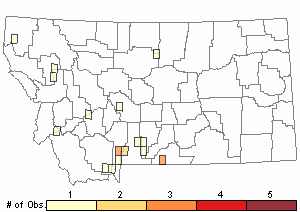
Recency
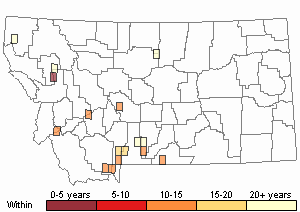
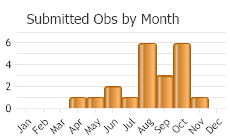
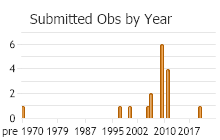
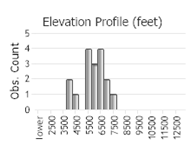 (Observations spanning multiple months or years are excluded from time charts)
(Observations spanning multiple months or years are excluded from time charts)
Habitat
Montane forests, often with a mixed conifer canopy including Engelmann spruce, subalpine fir, Douglas-fir, lodgepole pine and aspen with a secondary canopy of alder; also in riparian aspen stands or pockets of aspen. Found under woody debris and rocks, in leaf litter and duff (Hendricks 2012).
Ecology
The species can be abundant in colonies, but colony sites are relatively small in extent (Frest and Johannes 1993).
Reproductive Characteristics
Hermaphroditic. Copulation observed in March-June. Egg laying occurs from April-August in the Black Hills; clutch size is relatively small (3-6). Apparently most members of this species have a one-year life cycle (Frest and Johannes 1993).
Stewardship Responsibility
Threats or Limiting Factors
Major threats to known sites include degradation due to timber harvest and livestock grazing, with the latter likely the main threat (Frest and Johannes 1993). Fire is also a concern; stand replacement fires could permanently eliminate populations in isolated colonies (see Beetle 1997). Response of snails to fire retardants has not been studied.
References
- Literature Cited AboveLegend:
 View Online Publication
View Online Publication Beetle, D.E. 1997. Recolonization of burned aspen groves by land snails. Yellowstone Science 5 (summer):6-8.
Beetle, D.E. 1997. Recolonization of burned aspen groves by land snails. Yellowstone Science 5 (summer):6-8. Burke, T. E. 2013. Land snails and slugs of the Pacific Northwest. Corvallis, OR: Oregon State University Press. 344 p.
Burke, T. E. 2013. Land snails and slugs of the Pacific Northwest. Corvallis, OR: Oregon State University Press. 344 p. Frest, T. J. and E. J. Johannes. 1993. Land snail survey of the Black Hills National Forest, South Dakota and Wyoming. Deixis Consultants, Seattle, WA. 278 pp.
Frest, T. J. and E. J. Johannes. 1993. Land snail survey of the Black Hills National Forest, South Dakota and Wyoming. Deixis Consultants, Seattle, WA. 278 pp. Hendricks, P. 2003. Status and conservation management of terrestrial mollusks of special concern in Montana. Unpublished report prepared for the U.S. Forest Service. Montana Natural Heritage Program, Helena, Montana. 67 pp. + appendices.
Hendricks, P. 2003. Status and conservation management of terrestrial mollusks of special concern in Montana. Unpublished report prepared for the U.S. Forest Service. Montana Natural Heritage Program, Helena, Montana. 67 pp. + appendices. Hendricks, P. 2012. A Guide to the Land Snails and Slugs of Montana. A report to the U.S. Forest Service - Region 1. Montana Natural Heritage Program, Helena, MT. vii + 187 pp. plus appendices.
Hendricks, P. 2012. A Guide to the Land Snails and Slugs of Montana. A report to the U.S. Forest Service - Region 1. Montana Natural Heritage Program, Helena, MT. vii + 187 pp. plus appendices.
- Additional ReferencesLegend:
 View Online Publication
View Online Publication
Do you know of a citation we're missing? Beetle, D. E. 1961. Mollusca of the Big Horn Mountains. The Nautilus 74:95-102.
Beetle, D. E. 1961. Mollusca of the Big Horn Mountains. The Nautilus 74:95-102. Beetle, D.E. 1957. The Mollusca of Teton County, Wyoming. Nautilus 71:12-22.
Beetle, D.E. 1957. The Mollusca of Teton County, Wyoming. Nautilus 71:12-22. Forsyth, R.G. 2004. Land snails of British Columbia. Royal British Columbia Museum: Victoria, British Columbia, Canada. 188 pp.
Forsyth, R.G. 2004. Land snails of British Columbia. Royal British Columbia Museum: Victoria, British Columbia, Canada. 188 pp. Henderson, J. 1924. Mollusca of Colorado, Utah, Montana, Idaho, and Wyoming. University of Colorado Studies 13(2):65-223.
Henderson, J. 1924. Mollusca of Colorado, Utah, Montana, Idaho, and Wyoming. University of Colorado Studies 13(2):65-223. Hendricks, P., B.A. Maxell, S. Lenard, and C. Currier. 2007. Land mollusk surveys on USFS Northern Region lands: 2006. A report to the USDA Forest Service, Northern Region. Montana Natural Heritage Program, Helena, Montana. 11 pp. plus appendices.
Hendricks, P., B.A. Maxell, S. Lenard, and C. Currier. 2007. Land mollusk surveys on USFS Northern Region lands: 2006. A report to the USDA Forest Service, Northern Region. Montana Natural Heritage Program, Helena, Montana. 11 pp. plus appendices. Pilsbry, H.A. 1948. Land Mollusca of North America (north of Mexico), Volume II Part 2. The Academy of Natural Sciences of Philadelphia Monograph Number 2(2): 521-1113.
Pilsbry, H.A. 1948. Land Mollusca of North America (north of Mexico), Volume II Part 2. The Academy of Natural Sciences of Philadelphia Monograph Number 2(2): 521-1113.
- Web Search Engines for Articles on "Striate Disc Snail"
- Additional Sources of Information Related to "Snails / Slugs"





